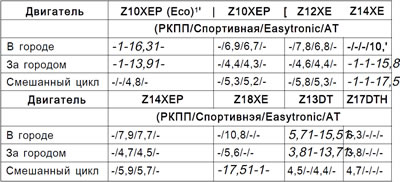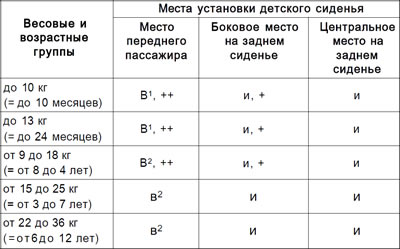Note: Depending on the elements of the special configuration, the data may differ from those given - the relevant certificate can be obtained from the official representatives of Opel.
Engine
See Specifications for Chapter 2.
Transmission
Drive - Front (2WD models)
Manual transmission - 5-speed fully synchronized
AT4 - step with electronic control
Easytronic - 5-speed, with automatic clutch control and shift mechanism
Brake system and suspension
Type of brake system - Hydraulic, dual circuit, vacuum boosted, ABS
Front wheel brakes - Disc (with appropriate configuration - ventilated)
Rear wheel brakes - Disc or drum type
Parking brake drive - cable, on the rear wheels
Front suspension - Independent, spring, type McPherson, with anti-roll bar
Rear suspension - Semi-independent, torsion bar, with coil springs and, depending on the model, anti-roll bar
Steering
Drive type - Rack and pinion with electric booster
Dynamic characteristics
Maximum travel speed, km/h
Note: The maximum speed can be developed no more than at half load from the maximum allowable. The complete set of the vehicle with additional components and assemblies may lead to a decrease in the actually developed maximum speed relative to the given values.
Corsa C

1. Fuel-optimised equipment options
Corsa Combo

Meriva

Fuel consumption, CO2 emissions (on the example of Corsa C models)
Since 1996, the regulation 80/1268/EWG in the latest modification 1999/100/EC has been in force for determining fuel consumption.
The instruction is based on real traffic conditions: driving in the city is evaluated with a coefficient of 1/3, and outside it: 2/3, taking into account cold starts and acceleration phases. An integral part of the instruction is an indication of the obligation to publish carbon dioxide emissions (CO2).
Note: The given data are indicative only. When determining fuel consumption according to the 1999/100EG standard, the dead weight of the vehicle, which is set according to the same instructions, is taken into account. Equipping a vehicle with additional devices and assemblies leads to a change in mass, which inevitably affects the amount of fuel consumption and CO2 emissions. The condition and correct installation of tires and wheels has a great influence on fuel consumption.
Fuel consumption (l/100 km)

CO2 emission (g/km)

Tire size and inflation pressure
See also Chapter 1, Section 5.
Note: Not all tires currently on the market meet the design requirements of cars - before purchasing new tires, consult with specialists.
Attention: Tires of sizes 195/45 R 16 and 205/40 R 17 cannot be used as winter tyres! Fitting a spare wheel with summer tires to a vehicle with winter tires may affect the handling of the vehicle - replace the spare wheel with a suitable new one as soon as possible!
Air pressure must be checked with cold tires (see Section 27).
Attention: If the air pressure in the tires increases during a long trip due to heating, do not under any circumstances reduce it!
The given tire pressures are the same for summer and winter tyres. The spare tire must always be maintained at full load air pressure. The tire pressures for your specific model are also listed on the label located on the inside of the fuel filler cap. In case of discrepancy between the data, follow the instructions on the vehicle plate.
Tire pressure of front/rear wheels, bar (1 bar = 100 kPa)

1. Cannot be used in winter operating conditions
2. Only in winter conditions
Ensuring the safety of transporting children
Attention: Statistics of deaths and injuries in road accidents show that it is safest to install child seats in the outermost places of the rear row of seats!
Child seat matching table

IN1 - Only on models not equipped with a front passenger airbag or with a seat occupied recognition system and a special Opel child seat with transponders. The front passenger seat must be pushed back as far as it will go. In addition, it must be equipped with a height adjuster that is set to the highest position, while the upper adjustable seat belt anchor must be lowered to the lowest position.
IN2 - Only on models not equipped with side airbags, as well as with a seat occupancy recognition system and a special Opel child seat with transponders. The front passenger seat must be pushed back as far as it will go. In addition, it must be equipped with a height regulator, which is set to the highest position.
U - Universal suitability in combination with a three-anchor seat belt.
+ - For seat with ISO-FIX attachment. When using an ISO-FIX anchorage, only ISO-FIX child restraint systems approved for this type of vehicle must be used.
++ - For branded ISO-FIX seats. These seats are designed to fit the Corsa C model only.
Dimensions

Weight characteristics
Attention: Non-compliance with the normative weight characteristics leads to increased wear of all vehicle components, deterioration of controllability and, in a difficult traffic situation, can cause an accident!
The vehicle's payload is the difference between the gross vehicle weight and the curb weight of the vehicle. Data on the standard load of the car are given on the nameplate located on the B-pillar in the opening of the front passenger door (see chapter 1), and in the car's passport.
To determine the mass of the car in running order, it is necessary to add the values \u200b\u200bof the corresponding indicators given in the tables for a specific configuration (see tables).
Note: Elements of special configuration increase the curb weight of the vehicle, while the payload is reduced.
The total load on the front and rear axles must not exceed the full standard load. For example, if the front axle is loaded at the maximum standard load, then the rear axle can only be loaded so as not to exceed the gross vehicle weight. In addition, by reducing the load on one axle, it is impossible to increase the load on the other in excess of the standard load for this axle.
When using a trailer on Corsa C models when the tractor vehicle is fully loaded (taking into account the weight of all passengers) the load on the rear axle should not exceed the standard by more than 45 kg, and the total standard weight of the car - by more than 15 kg. In extreme cases, if these indicators are exceeded, the car is allowed to move at a speed of no more than 100 km / h.
Note: If the Rules define lower speeds when operating a vehicle with a trailer, follow the established requirements.
On Combo and Meriva models, exceeding the standard axial loads is unacceptable!
The values listed below are individual, depending on the version and equipment of the vehicle, and are indicated on the rating plate (see chapter «Introduction»):
- Regulatory gross weight
- Standard load on the front axle
- Regulatory load on the rear axle
- The maximum permissible weight of the towed load
The maximum vertical hitch load depends on the model and type of the hitch and is specified in the documentation accompanying the vehicle and on the label of the tow hitch.
Maximum allowable load on the roof, kg: 100.
Note: The roof load is the sum of the weight of the roof rack and the weight of the load.
Weight of the car in running order (kg)11
Note: The tables contain data for the basic configuration of the models.
3 door hatchback

5 door hatchback

Corsa van

Combo van

Combo Combi/Tour

11 According to EU regulations, the curb weight of the car includes the weight of the car, the weight of the driver (68 kg), baggage weight (7 kg) and all filled fluids (fuel tank is 90% full).
Weight of heavy accessories (kg)
Corsa C
| Equipment items | Weight |
| top hatch | 18 |
| Drawbar hitch | 15 |
| ABS | 7 |
| Electric power steering | 8 |
| Power windows | 5 |
| Side airbags | 6 |
| Cargo floor covering | 7 |
Combo
| Equipment items | Weight |
| top hatch | 18 |
| Drawbar hitch | 18 |
| ABS | 7 |
| sliding door | 23 |
| Rear swivel glass | 9 |
| Removable luggage compartment net | 8 |
| Permanently installed luggage compartment netting | 10 |
Drawbar Mounting Dimensions
See Section 32 for detailed recommendations for operating a vehicle with a trailer tow hitch.
Below are the installation dimensions. All dimensions shown refer to the trailer hitch fitted at the factory.
Note: Aftermarket installation of the trailer tow hitch must be carried out by an Opel workshop. Before purchasing, please consult your dealer about approved tow hitch designs for this model.
Corsa C models (Hatchback)

Combo Models

Tightening force of threaded connections, Nm
Wheel bolts - 110

Visitor comments